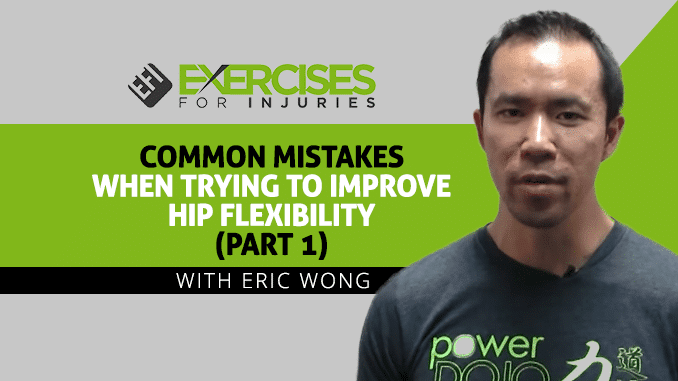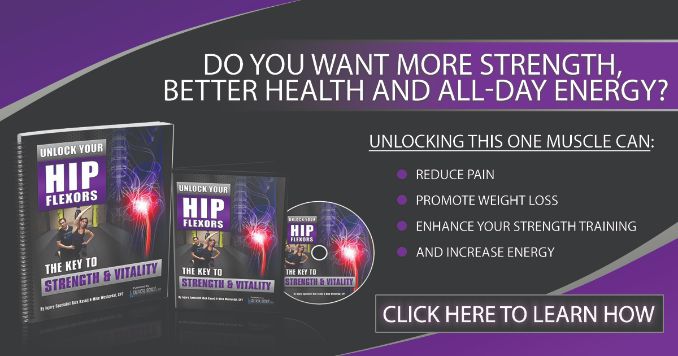
Whether you’re a stay-at-home mom who wants to be more active or an athlete looking to improve your performance, improving hip flexibility is essential.
However, many people make common mistakes when trying to achieve this goal. This blog post will discuss the most common mistakes and how to avoid them. Stay tuned!
CLICK HERE to watch the YouTube video.
In the above interview, you will discover:
- The importance of having good hip flexibility
- The disadvantages of having tight hip flexors
- Activities that lead to poor hip flexibility
- Ways to prevent having tight hip flexors
- How to improve your hip flexibility
I hope you enjoy the interview.
Flexibility is the ability of a joint or series of joints to move through a free, pain-free range of motion. Although flexibility varies widely from person to person, minimum ranges are necessary for maintaining joint and total body health.
Joints are very important in our day-to-day lives. They allow for movement and give stability when walking, running, or even sitting at a desk all afternoon!
But what happens if they lose their normal range of motion?
That would not be good news since it can lead directly to chronic pain over time caused by tightening muscles around the joints, which causes you to stop moving normally again (and then maybe find yourself on disability).
So make sure that doesn’t happen. Otherwise, there are ways around this problem-like keeping yourself active by doing exercises or yoga.
To understand how all the stretches and exercises in this article come together, it’s important first to understand how the hip works.
Hip 3 Main Movements:
- Flexion and Extension: moving the hip backward and forward
- Abduction and Adduction: moving the hip out to the side and bringing it back in
- Rotation: moving the hip in a circular motion
Hip 3 Basic Components:
- Bones: the main bones of the hip are:
- Ilium: supports everything from sitting to standing up, as well as many other functions that keep you alive
- Ischium: an important part of the lower back, providing support and stability when you bend over or sit down
- Pubis: a muscular structure that supports some of the female reproductive organs, such as those in charge of menstruation and urination
-
- Articular Cartilage: allows for movement at different joints, like when you shake your hand or clap it
- Muscles: grow in response to exercise and injury
- Iliopsoas: also known as the “hollow leg,” is a muscle that links your lower back to your hip.
- Rectus Femoris: a muscle that arises from the rear and front of your hip bone, which powers forward extensions into your legs.
- Sartorius: help humans with balance and movement
- Ligaments and Tendons: attach muscles to bones
- Synovial Membrane and Fluid: lines the cavity in which bones form
The body is a complex system that has developed over time. By being inactive, you are preventing your self-improvement and limiting your body’s full potential regarding flexibility and range of motion.
Effects of Being Inflexible
Inadequate flexibility will harm the body in 3 significant ways:
- Joints must move through a full range of motion for the Cartilage and other structures, like ligaments, to withstand increased stress. The joint movement also increases blood flow with more nutrient supply, as the extra synovial fluid (oil) helps keep your joints healthy. This effect may be particularly noticeable in weight-bearing joints such as hips or knees.
- If you have inflexible muscles, they will tire more quickly, which causes opposing groups of muscles to work harder. This can also lead to muscular injuries and the inability of our joints to take more severe impacts since we might not be able to protect them if something happens. A common example would be our hamstring, which helps us stabilize our knees and prevents ACL tears or a tear or sprain of the anterior cruciate ligament.
- It has been shown that decreased flexibility can lead to abnormal stress on structures and tissues distant from the initial site of inflexibility. One example is when tightness in your calf causes tendonitis, which may be related to issues like knee pain or inflammation elsewhere in the body.
A stretching routine is more than just a way to keep your muscles limbered up!
Stretching can be of great benefit as it increases neuromuscular coordination and improves circulation and muscle recovery.
Tight Hip Flexors Can Set Your Entire Body Up For Injury
Sciatic nerve damage and chronic joint pains have one thing in common – – we experience them when a herniated disk or the spine narrows and compresses part of the nerve, which causes the inflammation.
Sitting is one of the most common causes of lower back pain, knee joint discomfort, and imbalances in muscle strength.
What is Static Stretching?
Static stretching is often considered a passive activity, but it has some active properties that make it better for your muscles than just sitting around.
The stretches you hold in place can loosen up tight muscles while also increasing flexibility and range of motion.
Why is Dual Contract Relax Stretching Better than Static Stretching?
One of the most popular methods involves contracting and relaxing certain parts of muscle groups to stretch them further than they could go on their power – this technique is called Dual Contract-Relaxation (DCR).
The DCR method allows you to stretch deeper by contracting the joint on one side while lengthening or relaxing the joint on the opposite side. The Dual Contract Relax technique requires more effort because two separate sets are utilized instead of just the basic static stretches.
To improve our bodies, we must balance pushing ourselves forward and taking time off for maintenance.
Maintaining an even workload is important, especially when trying new things in your workout! Whether it’s during or after your workout, it varies depending on what type of exercise you do. But generally speaking, the progression-regression cycle will help our form and fitness level in the long run.
If you want more information on hip flexibility, click this link to grab your copy of the Hip Flexibility Solution. If you know of someone that would be great to interview, please email our team with your suggestion. Or, if you have an injury story or something that would benefit health and fitness professionals, don’t hesitate to get in touch with me.
Take care, and have a great day.
If you would like to improve your hip flexibility, then check out Hip Flexibility Solution here:
.


